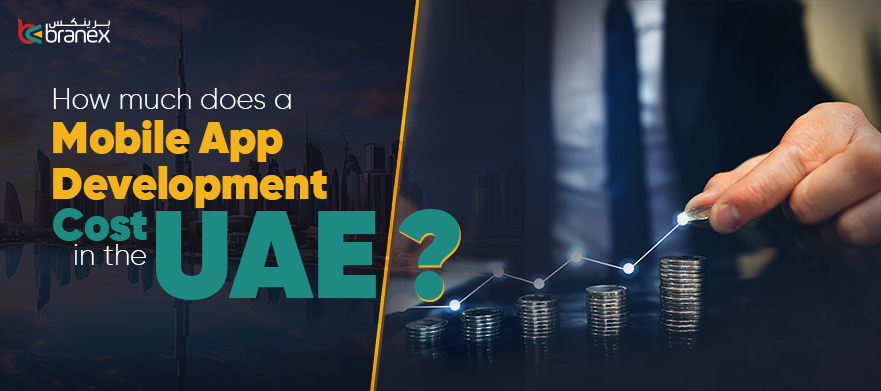
The Top 8 Benefits of Implementing DevOps within Organization
March 26, 2024
The Power of GoLang – Why Every Developer Should Embrace It?
April 3, 2024How Much Does a Mobile App Development Cost in the UAE?

It must be the first thing that would have come to your mind when you thought of building a mobile app for your business. Whether you’re a startup, a well established business or an enterprise looking to digitally transform your current business by making it mobile, the required cost for its development is of high importance.
Whether you’re a restaurant chain, a newspaper company, a laundry service, or some other commercial business, in today’s day and age, almost every business finds value by building a mobile app experience for their respective business.
Entering 2024, there are various trends that have dramatically changed in almost every industry vertical including mobile apps. As per a recent report, the total number of mobile app downloads have dramatically increased by 23% alone in 2022 and the numbers are expected to grow with an app market share value of up to 221.5 million just alone by 2027.
It opens a new gate of opportunities for entrepreneurs and startups.
In this article, we are going to share all about mobile app development cost in UAE, the various factors which affect its overall development cost and how you can easily earn money through these mobile app solutions. So without further ado, let’s dive deeper and explore.
Table of Contents
Important Facts on Why Should You Invest in a Mobile App
Do you know there are thousands of apps which are released on a daily basis?
More than 100,000 apps are released on a monthly basis especially on the two major app stores, Google Play Store & Apple App Store.
Google Play Store adds around 70,000 apps every month whereas, Apple App Store adds 30,000.
- UAE is a Mobile-First Nation: The UAE boasts one of the highest smartphone penetration rates globally, with nearly the entire population owning a smartphone. This means that your target audience is already using their phones for a multitude of tasks, and having a mobile app can put your business right at their fingertips.
- Mobile Apps Drive Customer Engagement: UAE consumers are increasingly turning to mobile apps to interact with businesses. In fact, research shows a 23% increase in mobile app installs in the UAE in the first half of 2022 alone. A well-designed app can provide a seamless and convenient way for customers to learn about your products and services, make purchases, and get in touch with you.
- Mobile Apps are Powerhouses for Sales: With a high mobile POS payment penetration rate, UAE consumers are comfortable making purchases through their phones. Your app can act as a virtual storefront, allowing customers to browse your products, compare prices, and make secure payments easily.
- Mobile Apps Increase Brand Loyalty: Mobile apps can be a powerful tool for building brand loyalty. By providing features like loyalty programs, push notifications, and personalized recommendations, you can keep your customers engaged and coming back for more.
How Much Does a Mobile App Cost on Average?
In short, investing in a mobile app is a great way for UAE businesses to reach a wider audience, improve customer engagement, and boost sales. But how much does an overall mobile app development cost in dubai on average, like what should be an average ball park figure a business owner in Dubai should have in mind when going that route?
The average cost of a mobile app depends on a number of factors such as the cost of the app, the app size, the platform on which you want to develop the app, the features you want to invest in, and the location where you want your app to be developed at.
In our case, it’s the ever-evolving landscape of the UAE. That being said, the average cost of a mobile app can vary from $40,000 up to $200,000 (AED 146,800 up to AED 734,000).
How Branex Calculates Mobile App Cost?
At Branex, we understand the importance of transparent cost estimation for your mobile app project. Here’s a formula to help you estimate the right cost of your mobile app.
Key Factors:
- Total Development Time (TDT): It represents the total number of hours required to develop the app. It encompasses all stages, including planning, design, development, testing, and deployment. Factors influencing TDT include app complexity, features, and platform(s) targeted.
- Hourly Rate (HR): This reflects the cost per hour of the development team you choose. Rates can vary depending on the team’s location, experience level, and expertise.
- Complexity Factor (CF): This is a multiplier that accounts for the relative complexity of your app’s features and functionalities. Here’s a breakdown:
- Simple App (Basic Features) – CF = 1.0
- Medium Complexity App (Moderate Features) – CF = 1.5
- Complex App (Advanced Features) – CF = 2.0
- Highly Complex App (Extensive Features) – CF = 2.5
- Platform Factor (PF): This factor reflects the number of platforms you’re targeting for your app:
- Single Platform (e.g., Android) – PF = 1.0
- Dual Platform (e.g., iOS & Android) – PF = 1.2
- Multi-Platform (e.g., iOS, Android, Others) – PF = 1.5
- Design Cost (DC): This represents the estimated cost associated with designing your app’s user interface (UI) and user experience (UX). The cost can vary depending on the desired level of design complexity.
Formula:
Estimated Cost = TDT * HR * CF * PF + DC
Let’s assume you’re developing a medium complexity app (CF = 1.5) for both iOS and Android (PF = 1.2). You estimate the total development time to be 1,000 hours, and you’ve budgeted $50 per hour for development (HR = $50). The design cost is estimated at $10,000 (DC).
Estimated Cost = 1,000 hours * $50/hour * 1.5 * 1.2 + $10,000 = $120,000.
Factors That Affects Mobile App Development Cost in UAE
First things first, you may first decide what type of mobile app you wish to invest in. App types differ based on two things;
1) the development technology
2) the purpose of mobile apps.
Based on Technology:
- Native Apps: These are built specifically for a single platform (iOS or Android) using the platform’s native programming language (Swift for iOS, Java/Kotlin for Android). This allows for optimal performance, user experience, and access to device-specific features like camera or GPS.
- Web Apps: These are essentially mobile-friendly websites accessed through a web browser on your phone. They offer cross-platform compatibility but may have limitations in performance and functionality compared to native apps.
- Hybrid Apps: These combine elements of both native and web apps. They’re built using frameworks like React Native or Flutter, allowing them to run on multiple platforms while offering some native-like features.
- Progressive Web Apps (PWAs): These are advanced web apps that leverage modern web technologies to provide app-like experiences (push notifications, offline functionality) without requiring installation from an app store.
Here’s a chart that provides an estimated cost value of each mobile app based on technology.
Based on Purpose:
Mobile apps come in a wide variety of categories depending on their intended use. Here are some common ones:
- Lifestyle: These apps help manage daily tasks, including fitness trackers, food delivery, appointment booking, and social media.
- Utility: These provide essential functionalities like weather forecasts, maps, note-taking apps, and file management tools.
- Entertainment: This category encompasses games, music and video streaming apps, e-readers, and social networking platforms.
- Productivity: These apps help users be more efficient, including task management tools, document editing apps, communication tools, and cloud storage services.
- News & Information: These offer access to news publications, weather updates, financial information, and educational content.
- Games: This is a massive category of mobile apps for all ages and interests, ranging from casual puzzle games to complex strategy titles.
- Travel: These apps assist with travel planning and booking, including flight and hotel reservations, city guides, and language translation tools.
- Food: These apps allow users to order food delivery, make restaurant reservations, and explore dining options.
- Finance: These apps help manage personal finances, including mobile banking, budgeting tools, investment platforms, and cryptocurrency apps.
- Photo & Video: These apps provide tools for editing and sharing photos and videos, social media integration, and special effects.
- Shopping: These apps allow users to browse and purchase products online, compare prices, track orders, and manage shopping lists.
Similarly, you may find a chart showing the price of mobile app development cost based on purpose. Each mobile app can differ based on the different complexity factors.
Factors Affecting the Cost of a Custom App Development Project
When we talk about setting aside the cost or budget that is involved in developing a mobile app, there are a few things that need to be considered. These factors play an important role on how your mobile app is going to be valued. When you’re making due investments in something like an app development project, these are just a few factors that you may want to consider.
The Market Need & Existing Market Opportunity
Let’s say you’re a business owner planning to launch a mobile app from scratch. Don’t just jump on the app bandwagon! Before diving in, identify a genuine problem or unmet need in the market. Take for instance, the rise of food delivery apps like Uber Eats or Deliveroo. Both of these apps emerged because they addressed the growing demand for convenient meal delivery, a need not adequately fulfilled by traditional takeaway services.
Now explore who your target audience is, who you are building this app for? Imagine creating a fitness app focused solely on bodybuilding routines. While valuable for a specific niche, it wouldn’t cater to the broader audience interested in general fitness or weight loss. So it’s very important that you clearly define your ideal user persona, considering their demographics, interests, and tech-savviness.
Finally, do a thorough research on the existing apps in your chosen category. Learn what makes them different, what their strengths and weaknesses are and check what they are doing differently. For example, if you’re developing a language learning app, giants like Duolingo exist. However, by focusing on gamification and personalized learning paths, a new app could carve a space by offering a more engaging user experience.
App Conceptualization & Functionality
Value proposition is just as important as coming up with a robust app idea for your business. Ask yourself, what makes your app stand out? Think of Airbnb. One may find each listing on the platform featuring a detailed description with photos that shares a unique story about the host and their home. The approach has previously helped Airbnb to go a head and shoulder above in the app market, attracting more users who are seeking for personalized experiences. It also helped travelers connect with locals giving a much more immersive travel experience.
Next up are the features. You want your app to stand out uniquely and you certainly don’t want to overwhelm your app users with a cluttered experience. Start with the core functionalities that deliver value to your customers. For instance, photo-editing apps start with the basic editing tool such as the ones used for cropping and filters. Later on, more advanced features such as selective adjustments or special effects in later updates. Prioritize your end user requirement and then plan for the future iterations based on the user feedback.
A beautiful yet confusing app won’t retain users. Think of Instagram’s clean interface and intuitive navigation. Users can easily discover new content, post photos, and interact with friends. Invest in a user-friendly design that is both aesthetically pleasing and easy to navigate.
Development & Cost Considerations
Just as much as the platform is important, so is how to choose the right development technology. The platform will clearly depend on how you’re planning to design the app, how complex the app design is, and what resources will be used to make the app.
For instance, if you’re building a simple to-do list app, a web app might be sufficient. But for a graphically demanding game, a native app would be ideal. Refer back to the cost estimation chart you created to understand the cost implications of each approach. Having a skilled development team is of high significance, so look for a team that holds enough experience in desired target platforms like (iOS and Android), ideally belonging to your industry.
Your expertise can save you time and money by avoiding such roadblocks.
Building an app is just the beginning. Factor in ongoing costs for maintenance, bug fixes, and future updates to keep your app functioning smoothly and secure.
App Marketing & Growth Strategy
Even if you have made the best mobile app, it will become a hidden gem without proper App Store Optimization. Start with an appropriate app store optimization technique by introducing relevant keywords and adding useful visuals. By implementing these practices, you can develop an app that is easily discoverable and ensures it starts ranking in the required category.
Building a great app is only half the battle. You need a strategy to reach your target audience and convince them to download it. The best way to achieve that is to utilize social media marketing, influencer marketing, or paid advertising to get your app in front of the right users. Don’t let your app become a one-time download. You can always plan strategies which allow you to capitalize on considering push notifications, start loyalty programs rewarding app usage or introduce useful in-app features which encourage continued engagement.
For example, language learning apps might employ gamification elements like daily challenges or leaderboards to keep users motivated.
Additional Considerations
Monetization Strategy: How will your app generate revenue? Popular models include advertising, in-app purchases (like premium features), subscriptions (for ongoing access to content), or freemium models (offering a basic free version with paid upgrades).
Data Security and Privacy: With growing data privacy concerns, ensure your app adheres to regulations like GDPR (Europe) or CCPA (California). Implement robust security measures to protect user data, like secure logins and encrypted data storage.
Scalability and Future Growth: Imagine your app taking off! Consider how your app can handle a surge in users and potential future features. Building a scalable architecture from the start will prevent infrastructure bottlenecks down the line.
Key Takeaways:
- The cost of developing a mobile app in the UAE can vary greatly depending on several factors, including the complexity of the app, the platform(s) it is developed for, and the features it includes.
- The average cost of a mobile app in the UAE can range from $40,000 to $200,000 (AED 146,800 to AED 734,000).
- Here are some of the factors that can affect the cost of mobile app development:
- Type of mobile app (native, web, hybrid, PWA)
- Purpose of the mobile app
- Complexity of the app
- Platform(s) the app is developed for (iOS, Android, both)
- Design cost
- Development team location and experience
- Before you start developing a mobile app, it is important to consider the market need, your target audience, the app’s concept and functionality, and the development cost.
- Once your app is developed, you will also need to factor in the cost of marketing and growing your app.
- Here are some additional considerations for mobile app development:
- Monetization strategy
- Data security and privacy
- Scalability and future growth
Conclusion
Investing in a mobile app can be a great way for UAE businesses to reach new customers, boost engagement, and drive sales. However, it’s important to carefully consider your budget and requirements before diving in. By understanding the factors that affect development costs and creating a realistic budget, you can increase your chances of building a successful mobile app that delivers a positive return on investment.
Remember, the cost estimates provided are just a starting point. It’s always best to get in touch with a reputable mobile app development company in the UAE for a more accurate quote based on your specific needs. They guide you through the app development process, from ideation and design to development and launch, ensuring your app becomes a success story.












